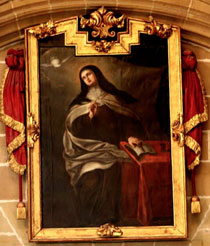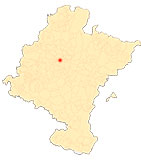pathway Teresian in Pamplona
In the cathedral: a relief and a canvas by Carlos Berdusán
The cathedral conserves two images of the saint, one in a relief on the altarpiece of Santa Catalina and the other on a canvas from the beginning of the 18th century. The first is located in one of the streets of the altarpiece of Santa Catalina, which had a very old confraternity. In 1683 the chapter, at proposalof the prior, agreed, "nemine discrepante", to apply the distribution of the food to the new altarpiece of Santa Catalina that was to be made because the old one was in a very bad state of repair. In 1686, the altarpiece was contracted out to Miguel de Bengoechea and José de Munárriz, the first one with the church's salomónicas. Its polychromy was carried out at positionby Juan de Munárriz in 1690. Along with saints of secular cult in Pamplona and in the chapterhouse, such as the Magdalene, the mythical Saint Babil or the Innocents, other iconographies more in tune with the new times were included, such as the Immaculate Conception, in a century that was quintessentially immaculist, Santiago on horseback and the saint in an attitude of writing with the Carmelite habit, inspired by the Holy Spirit and in a rapturous attitude, following 17th and 18th century praxis.
The canvas, signed and dated 1701, depicts the saint in ecstasy and also in her subjectas a mystical writer before a buffet dressed in rich crimson cloth. This is one of the very few works signed and dated by Carlos Berdusán, along with another of Saint John the Baptist in Pamplona Cathedral. Both show how Carlos copied the style of his father, Vicente Berdusán, prolonging the outlines of his workshop in the early years of the 18th century. Carlos Berdusán was born in Tudela in 1668, was a painter, produced some works for the town council of Tudela and married Francisca Labastida in 1697, after the death of his father. Carlos's mother, Vicente Berdusán's widow, had donated to her son the "sketches and drawings of those left by the death of the said Vicente de Berdusán, his father, by his own hand and that of Carreño". This information could not be more enlightening of Vicente's relationship with Juan Carreño de Miranda and of the value given at that time to the drawings of that master and of Vicente Berdusán himself.
-
FERNÁNDEZ GRACIA, R., "El convento e iglesia de los Carmelitas Descalzos de Pamplona. Architecture", Príncipe de Viana, 164, 1981, pp. 787-818.
-
ECHEVERRÍA GOÑI, P. and FERNÁNDEZ GRACIA, R., "El convento e iglesia de los carmelitas descalzos de Pamplona. Exorno artístico", Príncipe de Viana, 164, 1981, pp. 819-891.
-
AZANZA LÓPEZ, J. J., Arquitectura Religiosa Barroca en Navarra, Pamplona, Government of Navarre, 1996.
-
FERNÁNDEZ GRACIA, R., El retablo barroco en Navarra, Pamplona, Government of Navarre, 2003.
-
FERNÁNDEZ GRACIA, R., The Immaculate Conception in Navarre. Art and devotion during the centuries of the Baroque Mentors, artists and iconography. Pamplona, Eunsa, 2004.
-
FERNÁNDEZ GRACIA, R., Engraving, Counter-Reformation and Teresian Carmel. The collection of engravings of the Discalced Carmelites of Pamplona and Leonor de la Misericordia (Ayanz and Beaumont). Pamplona, I. G. Castuera, 2004.
-
FERNÁNDEZ GRACIA, R., "Santa Teresa", Juan de Goyeneche y el triunfo de los navarros en la Monarquía Hispánica del siglo XVIII, Pamplona, Fundación Caja Navarra, 2005, p. 352.
-
FERNÁNDEZ GRACIA, R., "Algunas esculturas napolitanas en Navarra", Pulchrum. Scripta in honorem Mª Concepción García Gainza, Pamplona, Government of Navarre, department de Cultura y Turismo-Institución Príncipe de Viana, 2011, pp. 300-310.
-
TARIFA CASTILLA, M. J., "Aparición de Cristo a Santa Teresa", Pamplona y San Cernin 1611-2011. IV Centenary of the Vow of the City, Pamplona, Pamplona City Council, 2011, p. 176.












